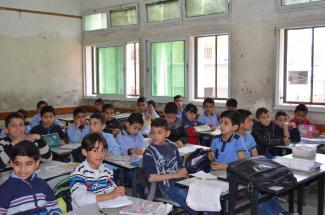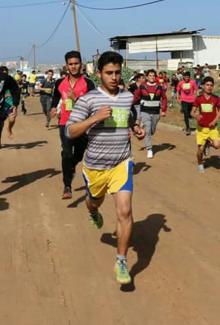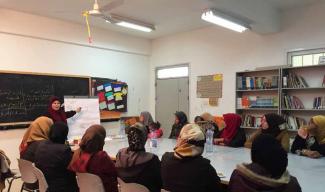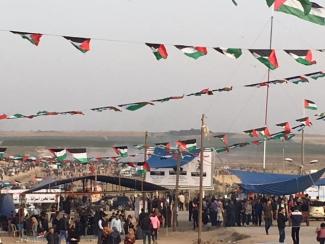In the Gaza Strip, recurrent conflict and the ensuing damage and destruction of educational facilities have disrupted services and impacted the psychosocial wellbeing of children and teachers.
The Monthly Humanitarian Bulletin | April 2018
40 Palestinians killed by Israeli forces during mass demonstrations in the Gaza Strip, and 6,800 injured; nearly 30 per cent of injuries by live ammunition (as of 30 April). Humanitarian agencies appealed for US$5.3 million for Gaza, for healthcare, mental health and psychological support, and protection monitoring. Electricity cuts of up to 20 hours a day continue to undermine service provision in Gaza, including education. Palestinian Bedouin community in Area C of the West Bank at heightened risk of forcible transfer following court hearing.
In this document
A series of demonstrations in the Gaza Strip since 30 March, near the perimeter fence with Israel, have resulted in large numbers of casualties and have raised serious protection concerns.
The extent of domestic, gender-based violence (GBV) across the occupied Palestinian territory (oPt) is believed to be significant. A 2010 survey by the Palestinian Central Bureau of Statistics (PCBS) revealed that 37 per cent of married Palestinian women had been subject to violence by their husbands, while nearly two-thirds of them (65.3 per cent) reported that they chose not to report the violence: only 0.7 per cent of these women sought assistance from specialized organizations. The survey indicated that the incidence of GBV in the Gaza Strip is significantly higher than in the West Bank.
Humanitarian actors have identified three critical areas of intervention arising from the events in Gaza, namely: providing immediate lifesaving healthcare; scaling up the provision of mental health and psychological support for people injured or otherwise affected by the events; and monitoring, verifying and documenting possible protection violations.
On 9 April, the right leg of Mohammed Al Ajouri, a 16-year-old boy and an athlete from Gaza featured in this Humanitarian Bulletin, was amputated. Ten days earlier he was shot and injured by Israeli forces while participating in the first of the “Great March of Return” series of Friday demonstrations, near the perimeter fence around Gaza. He is one of the nearly 2,000 Palestinians who, according to the Palestinian Ministry of Health figures, were injured by live ammunition since 30 March in such events. As of 30 April, 40 Palestinians have also been killed by Israeli forces during these demonstrations, and another ten in other circumstances. On successive Fridays since 30 March, hundreds of demonstrators, out of thousands, have approached the fence and attempted to damage it, burned tires, thrown stones and, to a lesser extent, Molotov cocktails towards Israeli forces deployed on the other side of the fence. No Israeli injuries have been reported. At present, there is no evidence that the demonstrators killed or injured by live ammunition have posed an imminent threat of death or risk of serious injury to Israeli soldiers, hence raising strong concerns of excessive use of force, according to the Office of High Commissioner for Human Rights.














